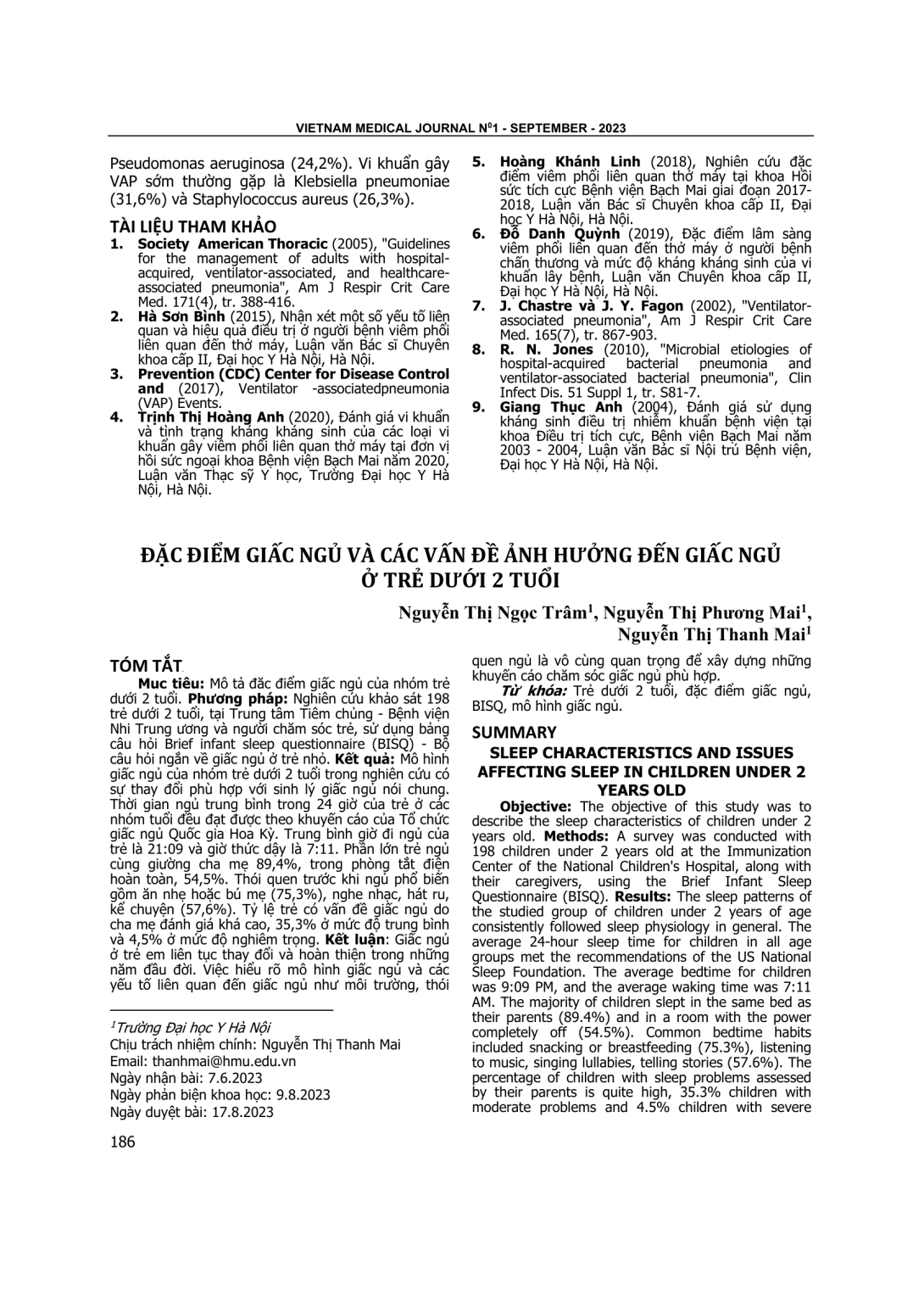
Mô tả đặc điểm giấc ngủ của nhóm trẻ dưới 2 tuổi. Phương pháp: Nghiên cứu khảo sát 198 trẻ dưới 2 tuổi, tại Trung tâm Tiêm chủng - Bệnh viện Nhi Trung ương và người chăm sóc trẻ, sử dụng bảng câu hỏi Brief infant sleep questionnaire (BISQ) - Bộ câu hỏi ngắn về giấc ngủ ở trẻ nhỏ. Kết quả: Mô hình giấc ngủ của nhóm trẻ dưới 2 tuổi trong nghiên cứu có sự thay đổi phù hợp với sinh lý giấc ngủ nói chung. Thời gian ngủ trung bình trong 24 giờ của trẻ ở các nhóm tuổi đều đạt được theo khuyến cáo của Tổ chức giấc ngủ Quốc gia Hoa Kỳ. Trung bình giờ đi ngủ của trẻ là 21:09 và giờ thức dậy là 7:11. Phần lớn trẻ ngủ cùng giường cha mẹ 89,4%, trong phòng tắt điện hoàn toàn, 54,5%. Thói quen trước khi ngủ phổ biến gồm ăn nhẹ hoặc bú mẹ (75,3%), nghe nhạc, hát ru, kể chuyện (57,6%). Tỷ lệ trẻ có vấn đề giấc ngủ do cha mẹ đánh giá khá cao, 35,3% ở mức độ trung bình và 4,5% ở mức độ nghiêm trọng. Kết luận: Giấc ngủ ở trẻ em liên tục thay đổi và hoàn thiện trong những năm đầu đời. Việc hiểu rõ mô hình giấc ngủ và các yếu tố liên quan đến giấc ngủ như môi trường, thói quen ngủ là vô cùng quan trọng để xây dựng những khuyến cáo chăm sóc giấc ngủ phù hợp.
The objective of this study was to describe the sleep characteristics of children under 2 years old. Methods: A survey was conducted with 198 children under 2 years old at the Immunization Center of the National Children's Hospital, along with their caregivers, using the Brief Infant Sleep Questionnaire (BISQ). Results: The sleep patterns of the studied group of children under 2 years of age consistently followed sleep physiology in general. The average 24-hour sleep time for children in all age groups met the recommendations of the US National Sleep Foundation. The average bedtime for children was 9:09 PM, and the average waking time was 7:11 AM. The majority of children slept in the same bed as their parents (89.4%) and in a room with the power completely off (54.5%). Common bedtime habits included snacking or breastfeeding (75.3%), listening to music, singing lullabies, telling stories (57.6%). The percentage of children with sleep problems assessed by their parents is quite high, 35.3% children with moderate problems and 4.5% children with severe problems. Conclusion: Children's sleep patterns and habits are constantly changing and improving during the first years of life. It is crucial to understand these factors, including the environment and bedtime habits, in order to develop appropriate sleep care recommendations.
- Đăng nhập để gửi ý kiến
